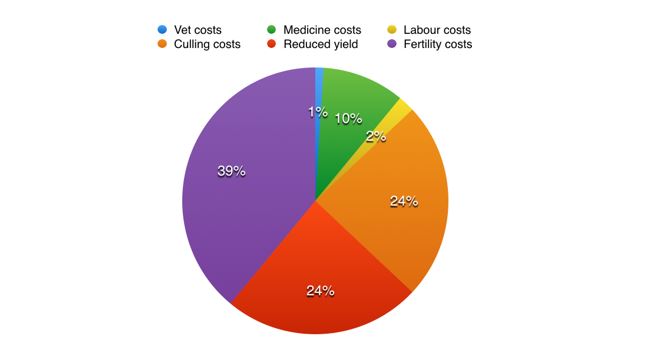What is the best way to express costs of lameness?
Monday, 27 April 2020
An economic review of the costs of lameness (Willshire and Bell, 2009) estimated the average lameness event costs in the region of £330. Of course, there is a large variation depending on the type of lesion and duration of lameness.
Typically, a case of digital dermatitis costs in the region of £75, a case of white line disease £300 and a sole ulcer £520. A decade later, whilst costs will have increased to some extent, it is still probably reasonable to base our estimates on these ball-park figures.
It is not always easy though for farmers to appreciate these costs. Maybe that is because they are mainly insidious losses rather than something a farmer has to write a cheque for. One UK study (Atkinson et al, 2013) found that 25% of farmers were simply unable to put any estimate on the economic effects of lameness within their herds. Those that did tended to underestimate by an average of 250%.
However, farmers were able to identify the three main economic impacts of lameness, namely:
- an increased risk of premature culling
- reduced fertility
- reduced milk yields.
Figure 1 shows the distribution of annual costs associated with lameness in a typical UK herd.

Figure 1. Breakdown of annual costs of lameness (from Willshire and Bell, 2009).
However, in order to use these estimates as a basis to calculate the overall economic impact of lameness in a herd, it is necessary to know accurate incidences of each type of lesion.
Not many farmers can accurately calculate their incidence of new lameness cases, let alone lesion types. And many incidences last several months, or even years - so it isn’t an easy measure to record. In fact, the average lameness incident is likely to last around 5 months (Green et al, 2002).
Perhaps a more simple way to calculate the economic impact of lameness, therefore, is on a cost per lame cow per day basis, rather than a cost per case.
Using the data presented, the average lameness case costs £2.20 for every day the cow is lame. This is a simple figure to remember. To work out the overall cost for a herd, the only other ingredient required is a herd mobility score.
Taking an example of a 200 cow herd with a 25% prevalence of Mobility Score (MS) 2 and 3 cows (“lame”), this will carry an economic tariff due to lameness of £110 per day:
200 x 0.25 x £2.20 = £110
Assuming the lameness prevalence remains constant through the year, this means that lameness is likely to be costing this herd around £40,000 per year. Assuming typical yields (8500 litres/cow/year), this is around 2.3 pence per litre.
There are clearly some large assumptions and generalisations made, including that all lame cows cost the same each day. In fact, more severely lame cows are likely to be costing more than those which display less severe lameness. But £2.20 per day is an average figure taking into account the relative prevalences of lameness severity, and independent of the lesion type. Furthermore, experience suggests that farmers find it a perfectly reasonable figure to use, remembering that some of that daily cost is due to poorer fertility, some due to less milk, some due to extra culling costs, and a proportion due to treatment costs.
What is important is that for most farms, there are some massive potential savings to be made, even with quite modest lameness reductions. For example, if lameness was reduced to 15% prevalence (MS 2 and MS 3 cows) in our example herd, this would be equivalent to an extra penny a litre.
Find me a farmer who is going to say no to that!
References:
Atkinson O, Fisher G, Cross K, 2013. Cattle Mobility: changing behaviour to improve health and welfare and dairy farm businesses. http://www.reaseheath.ac.uk/wp-content/uploads/2014/02/Cattle-Mobility-Final-report-December-2013.pdf (accessed 5th January 2017)
Green LH, Hedges VJ, Schukken YH, Blowey RW, Packington AJ, 2002. The impact of clinical lameness on the milk yield of dairy cows. Journal of Dairy Science 85:9 2250-2256
Wiltshire JA, Bell NJ, 2009. An economic review of cattle lameness. Cattle Practice 17:2 136-141

